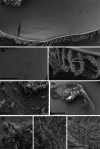Symbioses of alvinocaridid shrimps from the South West Pacific: No chemosymbiotic diets but conserved gut microbiomes
- PMID: 37752716
- PMCID: PMC10667644
- DOI: 10.1111/1758-2229.13201
Symbioses of alvinocaridid shrimps from the South West Pacific: No chemosymbiotic diets but conserved gut microbiomes
Abstract
Rimicaris exoculata shrimps from hydrothermal vent ecosystems are known to host dense epibiotic communities inside their enlarged heads and digestive systems. Conversely, other shrimps from the family, described as opportunistic feeders have received less attention. We examined the nutrition and bacterial communities colonising 'head' chambers and digestive systems of three other alvinocaridids-Rimicaris variabilis, Nautilocaris saintlaurentae and Manuscaris sp.-using a combination of electron microscopy, stable isotopes and sequencing approaches. Our observations inside 'head' cavities and on mouthparts showed only a really low coverage of bacterial epibionts. In addition, no clear correlation between isotopic ratios and relative abundance of epibionts on mouthparts could be established among shrimp individuals. Altogether, these results suggest that none of these alvinocaridids rely on chemosynthetic epibionts as their main source of nutrition. Our analyses also revealed a substantial presence of several Firmicutes and Deferribacterota lineages within the foreguts and midguts of these shrimps, which closest known lineages were systematically digestive symbionts associated with alvinocaridids, and more broadly for Firmicutes from digestive systems of other crustaceans from marine and terrestrial ecosystems. Overall, our study opens new perspectives not only about chemosynthetic symbioses of vent shrimps but more largely about digestive microbiomes with potential ancient and evolutionarily conserved bacterial partnerships among crustaceans.
© 2023 The Authors. Environmental Microbiology Reports published by Applied Microbiology International and John Wiley & Sons Ltd.
Conflict of interest statement
The author declares no competing interests.
Figures







References
-
- Assié, A. (2016) Deep Se(a)quencing: A study of deep sea ectosymbioses using next generation sequencing.

